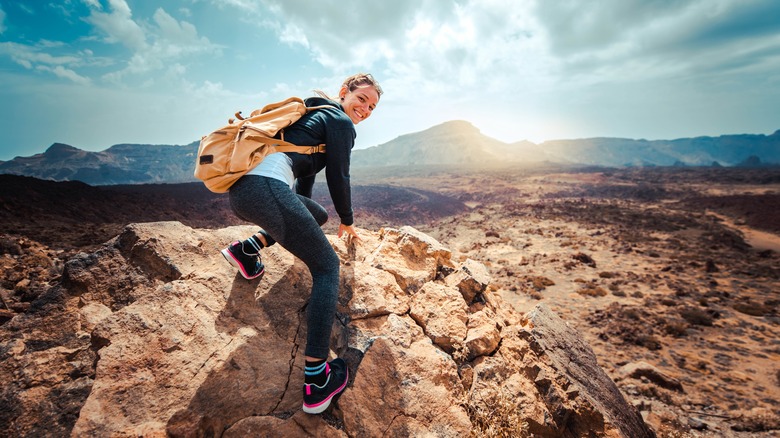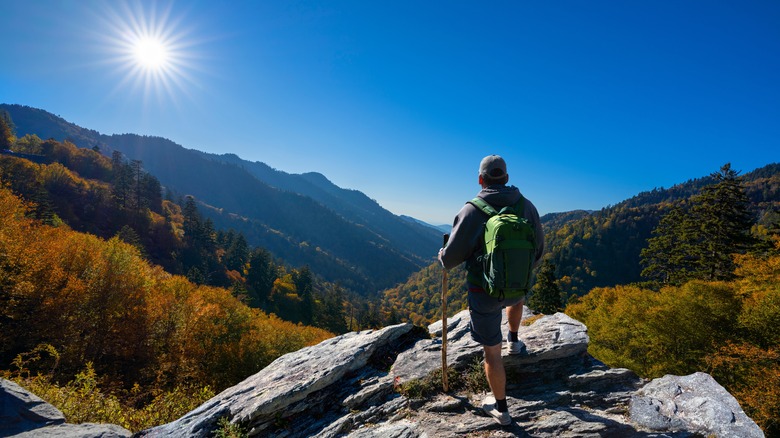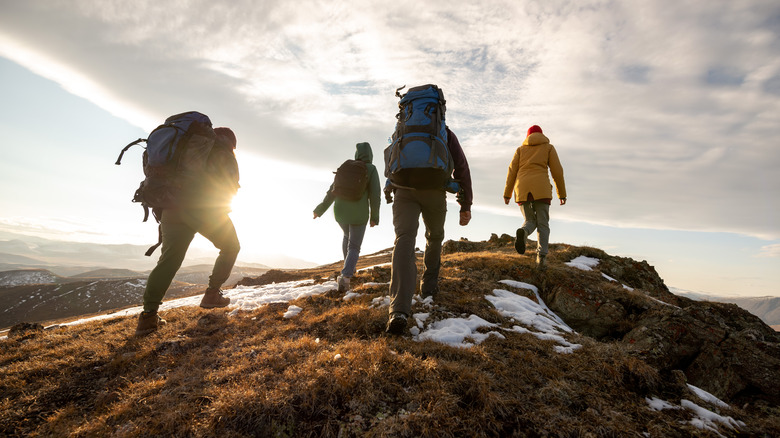Why Covering Up Is Better Than Just Wearing Sunscreen On The Trail
Modern sunscreen has had a large impact on the global reduction of sunburns, skin cancer, and early aging since its creation in 1946. However, it also has its disadvantages in that many sunblocks contain not-so-great chemicals that are absorbed by our skin and, if you plan on going for a dip, sunblocks containing oxybenzone and octinoxate have been proven to be bad for both ocean and freshwater ecosystems. Plus, as it turns out, when spending a long time out in the sun doing a physical activity — like hiking — it's easy to forget to apply sunblock often enough to prevent burning.
In fact, as professor and dermatologist Dr. Susan Weinkle explained in an interview with LiveScience, the best way to protect your skin while in the sun for long periods is by simply covering up with UV-protective clothing. This is because covering your skin with UV-resistant materials is a more long-term and reliable method than using just sunscreen. However, the only problem with official UV-rated clothing is that it can be pretty expensive. So, do you need to specifically buy UV-protective clothing? Or is regular clothing enough?
Types of clothing that protect your skin best
Now that we know that covering your skin is a more effective way to block UV rays than just wearing sunblock, let's take a look at what types of clothes work best. As it turns out, you don't necessarily need to purchase sun-protective clothing to prevent your skin from burning on the trail. Clothing made from regular materials that cover a large percentage of your skin can also protect you from UV rays while outside.
According to the Skin Cancer Foundation, clothes that are a darker color and tighter weave are often better than clothes that are sheer or light in color. This is because dark colors absorb more light and tighter weaves are better able to cover and protect skin. If you don't want to wear dark colors because they make you feel hotter, you can opt for breathable UV-absorbent fabrics like natural cotton or linen. Shiny fabrics like polyester and silk also do a good job of protecting you from burning because they reflect the light instead of allowing it to pass through.
To fully protect your skin without sunblock on the trail and maximize your time outdoors, you will need to cover all areas that are prone to burning. This includes sensitive places like your face, shoulders, and the back of your neck. You can do this using a wide-brim hat, a full-sleeve shirt, and sunglasses.
Why covering up is especially important in the mountains
While covering your skin is a more effective way to prevent sunburn at sea level, this method becomes especially important at higher elevations. This is because the strength of the sun's rays increases the higher in altitude you are. For every 1,000 feet you gain in elevation, the strength of the sun's UV rays increases by six to ten percent. The reason for this is that at higher altitudes the air is thinner and there is less ozone to protect you.
This means that you will be exposed to stronger UV rays the higher you go which is a problem because most sunscreen is designed to protect you from the strength of the sun at sea level. According to Steve Johnson the founder of Sol Sunguard in an interview with Ski Magazine, when chemical sunscreens are hit with UV rays that are too strong, the protective chemicals simply "decompose and the sunscreen stops working just about immediately."
In this situation, the most effective solution is to cover your skin with sun-protective clothing while on the trail instead of applying sunblock that may fail to protect you. If you want to use both protective clothing and sunblock, Johnson recommends going for mineral-based sunblocks because they hold up better to strong UV rays.


